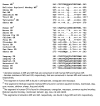Structural analysis of the evolution of steroid specificity in the mineralocorticoid and glucocorticoid receptors
- PMID: 17306029
- PMCID: PMC1805736
- DOI: 10.1186/1471-2148-7-24
Structural analysis of the evolution of steroid specificity in the mineralocorticoid and glucocorticoid receptors
Abstract
Background: The glucocorticoid receptor (GR) and mineralocorticoid receptor (MR) evolved from a common ancestor. Still not completely understood is how specificity for glucocorticoids (e.g. cortisol) and mineralocorticoids (e.g. aldosterone) evolved in these receptors.
Results: Our analysis of several vertebrate GRs and MRs in the context of 3D structures of human GR and MR indicates that with the exception of skate GR, a cartilaginous fish, there is a deletion in all GRs, at the position corresponding to Ser-949 in human MR. This deletion occurs in a loop before helix 12, which contains the activation function 2 (AF2) domain, which binds coactivator proteins and influences transcriptional activity of steroids. Unexpectedly, we find that His-950 in human MR, which is conserved in the MR in chimpanzee, orangutan and macaque, is glutamine in all teleost and land vertebrate MRs, including New World monkeys and prosimians.
Conclusion: Evolution of differences in the responses of the GR and MR to corticosteroids involved deletion in the GR of a residue corresponding to Ser-949 in human MR. A mutation corresponding to His-950 in human MR may have been important in physiological changes associated with emergence of Old World monkeys from prosimians.
Figures






Similar articles
-
Evolution of hormone selectivity in glucocorticoid and mineralocorticoid receptors.J Steroid Biochem Mol Biol. 2013 Sep;137:57-70. doi: 10.1016/j.jsbmb.2013.07.009. Epub 2013 Jul 29. J Steroid Biochem Mol Biol. 2013. PMID: 23907018 Review.
-
Role of Pro-637 and Gln-642 in human glucocorticoid receptors and Ser-843 and Leu-848 in mineralocorticoid receptors in their differential responses to cortisol and aldosterone.J Steroid Biochem Mol Biol. 2016 May;159:31-40. doi: 10.1016/j.jsbmb.2016.02.017. Epub 2016 Feb 22. J Steroid Biochem Mol Biol. 2016. PMID: 26907965
-
30 YEARS OF THE MINERALOCORTICOID RECEPTOR: Evolution of the mineralocorticoid receptor: sequence, structure and function.J Endocrinol. 2017 Jul;234(1):T1-T16. doi: 10.1530/JOE-16-0661. Epub 2017 May 3. J Endocrinol. 2017. PMID: 28468932 Review.
-
Analysis of the hormone-binding domain of steroid receptors using chimeras generated by homologous recombination.Exp Cell Res. 2005 Aug 15;308(2):320-33. doi: 10.1016/j.yexcr.2005.03.040. Exp Cell Res. 2005. PMID: 15936754
-
Cloning of partial cDNAs for the chicken glucocorticoid and mineralocorticoid receptors and characterization of mRNA levels in the anterior pituitary gland during chick embryonic development.Domest Anim Endocrinol. 2007 Aug;33(2):226-39. doi: 10.1016/j.domaniend.2006.05.006. Epub 2006 Jun 8. Domest Anim Endocrinol. 2007. PMID: 16787734
Cited by
-
Corticosteroid receptor expression in a teleost fish that displays alternative male reproductive tactics.Gen Comp Endocrinol. 2010 Jan 1;165(1):83-90. doi: 10.1016/j.ygcen.2009.06.004. Epub 2009 Jun 12. Gen Comp Endocrinol. 2010. PMID: 19524581 Free PMC article.
-
Evolution of hormone signaling in elasmobranchs by exploitation of promiscuous receptors.Mol Biol Evol. 2008 Dec;25(12):2643-52. doi: 10.1093/molbev/msn204. Epub 2008 Sep 17. Mol Biol Evol. 2008. PMID: 18799714 Free PMC article.
-
Regulation of cell volume and water transport--an old fundamental role of the renin angiotensin aldosterone system components at the cellular level.Peptides. 2014 Aug;58:74-7. doi: 10.1016/j.peptides.2014.06.003. Epub 2014 Jun 16. Peptides. 2014. PMID: 24945466 Free PMC article. Review.
-
Exploring Flexibility of Progesterone Receptor Ligand Binding Domain Using Molecular Dynamics.PLoS One. 2016 Nov 8;11(11):e0165824. doi: 10.1371/journal.pone.0165824. eCollection 2016. PLoS One. 2016. PMID: 27824891 Free PMC article.
-
Effects of social isolation on glucocorticoid regulation in social mammals.Horm Behav. 2012 Aug;62(3):314-23. doi: 10.1016/j.yhbeh.2012.05.011. Epub 2012 Jun 1. Horm Behav. 2012. PMID: 22663934 Free PMC article. Review.

